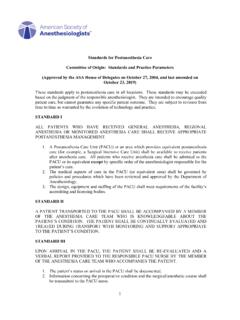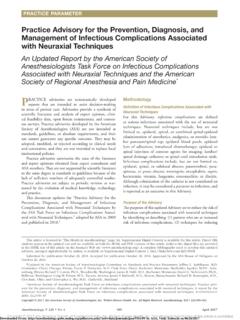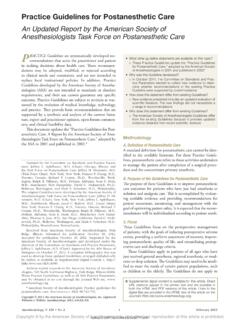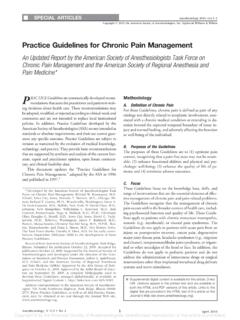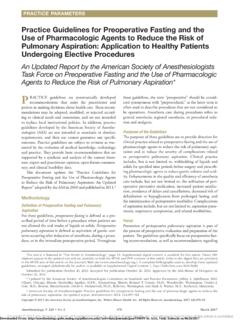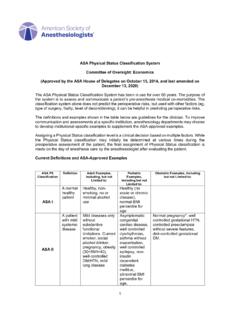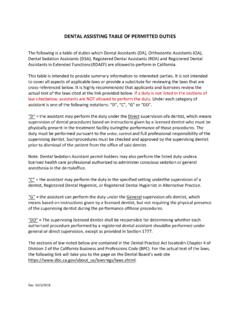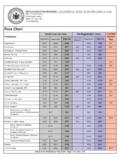Transcription of Practice Guidelines for Obstetric Anesthesia
1 Anesthesiology, V 124 No 2 1 February 2016 Practice Guidelines are systematically developed rec-ommendations that assist the practitioner and patient in making decisions about health care. These recommendations may be adopted, modified, or rejected according to the clini-cal needs and constraints and are not intended to replace local institutional policies. In addition, Practice Guidelines devel-oped by the American Society of Anesthesiologists (ASA) are not intended as standards or absolute requirements, and their use cannot guarantee any specific outcome. Practice Guidelines are subject to revision as warranted by the evolution of medi-cal knowledge, technology, and Practice . They provide basic recommendations that are supported by a synthesis and analy-sis of the current literature, expert and practitioner opinion, open-forum commentary, and clinical feasibility document updates the Practice Guidelines for Obstetric Anesthesia : An Updated Report by the ASA Task Force on Obstetric Anesthesia , adopted by ASA in 2006 and published in 2007.
2 MethodologyDefinition of Perioperative Obstetric AnesthesiaFor the purposes of these updated Guidelines , Obstetric anes-thesia refers to peripartum anesthetic and analgesic activities performed during labor and vaginal delivery, cesarean delivery, removal of retained placenta, and postpartum tubal of the GuidelinesThe purposes of these Guidelines are to enhance the qual-ity of anesthetic care for Obstetric patients, improve patient safety by reducing the incidence and severity of Anesthesia -related complications, and increase patient Guidelines focus on the anesthetic management of pregnant patients during labor, nonoperative delivery, operative delivery, and selected aspects of postpartum care and analgesia ( , neuraxial opioids for postpartum anal-gesia after neuraxial Anesthesia for cesarean delivery).
3 The intended patient population includes, but is not limited, Supplemental Digital Content is available for this article. Direct URL citations appear in the printed text and are available in both the HTML and PDF versions of this article. Links to the digital files are provided in the HTML text of this article on the Journal s Web site ( ). A complete bibliography used to develop these updated Guidelines , arranged alphabetically by author, is available as Supplemental Digital Content 1, for publication October 28, 2015. Accepted for publication October 28, 2015. Approved by the ASA House of Delegates on October 28, 2015.* Updated by the American Society of Anesthesiologists Committee on Standards and Practice Parameters: Jeffrey L. Apfelbaum, (Committee Chair), Chicago, Illinois; Joy L. Hawkins, (Task Force Chair), Denver, Colorado; Madhulika Agarkar, , Schaumburg, Illinois; Brenda A.
4 Bucklin, , Denver, Colorado; Richard T. Connis, , Woodinville, Washington; David R. Gambling, , San Diego, California; Jill Mhyre, , Little Rock, Arkansas; David G. Nickinovich, , Bellevue, Washington; Heather Sherman, , Schaum burg, Illinois; Lawrence C. Tsen, , Boston, Massachusetts; and Edward (Ted) A. Yaghmour, , Chicago, Illinois. Practice Guidelines for Obstetric Anesthesia : An updated report by the American Society of Anesthesiologists Task Force on Obstetric Anesthesia . ANESTHESIOLOGY 2007; 106:843 Guidelines for Obstetric AnesthesiaAn Updated Report by the American Society of Anesthesiologists Task Force on Obstetric Anesthesia and the Society for Obstetric Anesthesia and Perinatology* What other Guidelines are available on this topic? These Practice Guidelines update the Practice Guidelines for Obstetric Anesthesia : An Updated Report by the Amer-ican Society of Anesthesiologists Task Force on Obstetric Anesthesia , adopted by the American Society of Anesthe-siologists (ASA) in 2006 and published in Other Guidelines on the topic for the anesthetic manage-ment of the parturient have been published by the Ameri-can College of Obstetricians and Gynecologists in 2002 and reaffirmed in 2010 and Why was this guideline developed?
5 In October 2014, the ASA Committee on Standards and Practice Parameters, in collaboration with the Society for Obstetric Anesthesia and Perinatology, elected to collect new evidence to determine whether recommendations in the existing Practice Guidelines continue to be supported by current evidence. The resultant Guidelines , presented in this issue, incorporate an analysis of current scientific literature and expert consultant survey results. How does this statement differ from existing Guidelines ? This statement presents new findings from the scientific lit-erature since 2006 and surveys of both expert consultants and randomly selected ASA members. This document represents the first Practice guideline to be developed as a collaborative effort between the ASA and a subspecialty society (Society for Obstetric Anesthesia and Perinatology) with content expertise relevant to the recom-mendations.
6 Why does the statement differ from existing Guidelines ? The American College of Obstetricians and Gynecologists Practice Bulletin focuses on limited aspects of cesarean Anesthesia ( , when an anesthesiology consult is ap-propriate) and of labor analgesia ( , parenteral opioids) that an obstetrician would use to counsel their patients. These Guidelines also include perianesthetic management of other Obstetric procedures and 2015, the American Society of Anesthesiologists, Inc. Wolters Kluwer Health, Inc. All Rights Reserved. Anesthesiology 2016; 124:00 00 (Anesthesiology 2016; 124:00-00) Practice PArAMetersCopyright 2015, the American Society of Anesthesiologists, Inc. Wolters Kluwer Health, Inc. Unauthorized reproduction of this article is prohibited.<zdoi; >Anesthesiology 2016; 124:00-00 2 Practice GuidelinesPractice Guidelinesto intrapartum and postpartum patients with uncompli-cated pregnancies or with common Obstetric problems.
7 The Guidelines do not apply to patients undergoing surgery dur-ing pregnancy, gynecological patients, or parturients with chronic medical disease ( , severe cardiac, renal, or neuro-logical disease). In addition, these Guidelines do not address (1) postpartum analgesia for vaginal delivery, (2) analgesia after tubal ligation, or (3) postoperative analgesia after gen-eral Anesthesia (GA) for cesarean Guidelines are intended for use by anesthesiologists. They also may serve as a resource for other Anesthesia pro-viders and healthcare professionals who advise or care for patients who will receive anesthetic care during labor, deliv-ery, and the immediate postpartum Force Members and ConsultantsIn 2014, the ASA Committee on Standards and Practice Parameters requested that the updated Guidelines published in 2007 be reevaluated.
8 This current update consists of a lit-erature evaluation and the reporting of new survey findings of expert consultants and ASA members. A summary of rec-ommendations is found in appendix update was developed by an ASA-appointed Task Force of 11 members, consisting of anesthesiologists in both private and academic practices from various geographic areas of the United States, and consulting methodologists from the ASA Committee on Standards and Practice Parameters. The Task Force developed these updated Guidelines by means of a multistep process. First, original published research studies from peer-reviewed journals published subsequent to the previous update were reviewed. Second, a panel of expert consultants was asked to (1) participate in opinion surveys on the effectiveness of various anesthetic management strate-gies and (2) review and comment on a draft of the update developed by the Task Force.
9 Third, survey opinions about the guideline recommendations were solicited from a ran-dom sample of active members of the ASA. Finally, all avail-able information was used to build consensus within the Task Force to finalize the and Strength of EvidencePreparation of these Guidelines followed a rigorous method-ological process. Evidence was obtained from two principal sources: scientific evidence and opinion-based Evidence. Scientific evidence used in the devel-opment of these updated Guidelines is based on cumulative findings from literature published in peer-reviewed journals. Literature citations are obtained from PubMed and other healthcare databases, direct Internet searches, Task Force members, liaisons with other organizations, and manual searches of references located in reviewed from the aggregated literature are reported in the text of the Guidelines by evidence category, level, and direction.
10 Evidence categories refer specifically to the strength and quality of the research design of the studies. Category A evidence represents results obtained from ran-domized controlled trials (RCTs), and Category B evidence represents observational results obtained from nonrandom-ized study designs or RCTs without pertinent comparison groups. When available, Category A evidence is given prece-dence over Category B evidence for any particular outcome. These evidence categories are further divided into evidence levels. Evidence levels refer specifically to the strength and quality of the summarized study findings ( , statistical findings, type of data, and the number of studies reporting/replicating the findings within the evidence categories). In this document, only the highest level of evidence is included in the summary report for each intervention outcome pair, including a directional designation of benefit, harm, or equivocality for each A.
